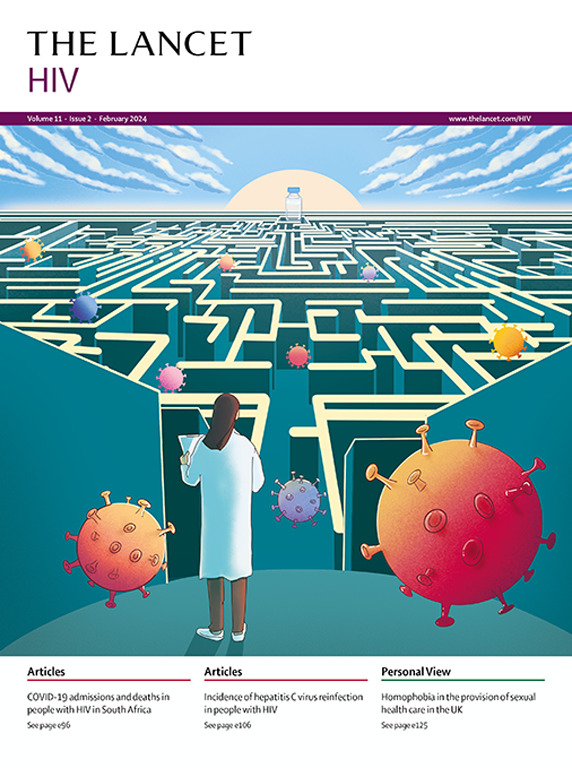基因型耐药检测对南非替诺福韦-拉米夫定-多鲁特格拉韦持续病毒学无抑制的患者的临床和经济影响:一项模拟研究。
IF 13
1区 医学
Q1 IMMUNOLOGY
引用次数: 0
摘要
背景:在接受替诺福韦-拉米夫定-多鲁地韦(TLD)治疗的HIV感染者中,持续的病毒学无抑制可能是由于依从性差,有或没有耐药性;然而,基因型耐药检测(GRT)在南非不被常规推荐。我们检查了GRT对所有被诊断为TLD持续病毒学无抑制的南非成年人的临床和经济效果。方法在本模型研究中,我们使用先前验证的预防艾滋病并发症的成本效益-国际微观模拟模型来比较三种策略:(1)持续TLD(基线);(2)立即改用替诺福韦-拉米夫定联合利托那韦增强的达那韦;(3)对于有替诺福韦-拉米夫定耐药的患者,GRT提示切换为替诺福韦-拉米夫定加利托那韦增强的达那韦;对于没有替诺韦耐药的患者,TLD提示切换为TLD延续。我们估计基线人群中分别有2.3%和28.5%的人对多替格拉韦和核苷逆转录酶抑制剂(NRTI)耐药。我们还研究了正在开发的低成本、即时护理尿液替诺福韦试验的效果,该试验用于检测近期抗逆转录病毒治疗的使用(84%的敏感性和50%的特异性),仅在阳性时使用GRT。费用包括GRT(每次检测157美元)、TLD(每年45美元)、替诺福韦-拉米夫定加利托那韦增强的达那韦(每年247美元)和替诺福韦尿液检测(每次检测2美元)。结果包括生命年限、成本(提供者观点)和增量成本-效果比(ICERs;$每残疾调整生命年[DALY])。我们考虑了每个DALY低于3310美元(基本情况)和每个DALY低于1100美元至4250美元的成本效益阈值。研究结果:根据我们的模型,我们估计持续TLD的结果为14.11个未折扣的生命年,并以3%的折扣成本为5380美元;GRT的寿命为14.36年,成本为5860美元(避免了0.14个DALYs折扣);(每天3500美元)。立即切换可以避免更少的DALYs和更高的成本。当基线多替替韦耐药流行率≥2.5%或基因型耐药检测成本≤147美元时,GRT的ICER为每DALY 3310美元或更低。尿替诺福韦试验确定GRT合格结果,ICER为2300美元/年;如果尿液测试特异性为0.87或更高,每次测试成本为2美元,或测试特异性高于0.98,每次测试成本为10美元或更低,则ICER将低于1100美元/ DALY。解释:在南非,grt可以提高艾滋病毒感染者的预期寿命和TLD的持续病毒学无抑制,并且可能具有成本效益,特别是在较低的检测成本下。以目前替诺福韦-拉米夫定加利托那韦增强的达那韦的有效性和成本来看,不建议立即转换。国家过敏和传染病研究所,尤尼斯·肯尼迪·施莱弗国家儿童健康和人类发展研究所,以及MGH杰罗姆和西莉亚·赖克艾滋病毒/艾滋病研究奖学金。本文章由计算机程序翻译,如有差异,请以英文原文为准。
The clinical and economic impact of genotypic resistance testing for people diagnosed with persistent virological non-suppression on tenofovir-lamivudine-dolutegravir in South Africa: a modelling study.
BACKGROUND
Persistent virological non-suppression among people with HIV receiving tenofovir-lamivudine-dolutegravir (TLD) can result from poor adherence with or without resistance; however, genotypic resistance testing (GRT) is not recommended routinely in South Africa. We examined the clinical and economic effect of GRT for all South African adults diagnosed with persistent virological non-suppression on TLD.
METHODS
In this modelling study, we used the previously validated Cost-Effectiveness of Preventing AIDS Complications-International microsimulation model to compare three strategies: (1) continued TLD (baseline); (2) immediate switch to tenofovir-lamivudine plus ritonavir-boosted darunavir; and (3) GRT prompting switch to tenofovir-lamivudine plus ritonavir-boosted darunavir for people with dolutegravir resistance or TLD continuation for people without dolutegravir resistance. We estimated that 2·3% and 28·5% of the baseline population have dolutegravir resistance and nucleoside reverse transcriptase inhibitor (NRTI) resistance, respectively. We also examined the effect of a low-cost, point-of-care urine tenofovir test in development to detect recent antiretroviral therapy use (84% sensitivity and 50% specificity), with GRT only when positive. Costs included GRT (US$157 per test), TLD ($45 per year), tenofovir-lamivudine plus ritonavir-boosted darunavir ($247 per year), and urine tenofovir testing ($2 per test). Outcomes included life-years, costs (provider perspective), and incremental cost-effectiveness ratios (ICERs; $ per disability-adjusted life-year [DALY]). We considered cost-effectiveness thresholds of less than $3310 per DALY (base case) and less than $1100 to $4250 per DALY.
FINDINGS
Based on our model, we estimated that continued TLD results in 14·11 undiscounted life-years and costs $5380 discounted at 3%; GRT results in 14·36 life-years and costs $5860 (0·14 discounted DALYs averted; ICER $3500 per DALY). Immediate switch results in fewer DALYs averted and higher costs. GRT has an ICER of $3310 per DALY or less when baseline dolutegravir resistance prevalence is ≥2·5% or genotypic resistance test costs ≤$147 per test. Urine tenofovir testing to identify GRT eligibility results in an ICER of $2300 per DALY; the ICER would be less than $1100 per DALY if urine test specificity is 0·87 or greater and costs $2 per test or test specificity is higher than 0·98 and costs $10 per test or less.
INTERPRETATION
GRT could increase life expectancy for people with HIV and persistent virological non-suppression on TLD in South Africa and could be cost-effective, especially at lower test costs. At current effectiveness and costs of tenofovir-lamivudine plus ritonavir-boosted darunavir, an immediate switch would not be preferred.
FUNDING
National Institute of Allergy and Infectious Diseases, the Eunice Kennedy Shriver National Institute of Child Health and Human Development, and the MGH Jerome and Celia Reich Endowed Scholar in HIV/AIDS Research Award.
求助全文
通过发布文献求助,成功后即可免费获取论文全文。
去求助
来源期刊

Lancet Hiv
IMMUNOLOGYINFECTIOUS DISEASES&-INFECTIOUS DISEASES
CiteScore
19.90
自引率
4.30%
发文量
368
期刊介绍:
The Lancet HIV is an internationally trusted source of clinical, public health, and global health knowledge with an Impact Factor of 16.1. It is dedicated to publishing original research, evidence-based reviews, and insightful features that advocate for change in or illuminates HIV clinical practice. The journal aims to provide a holistic view of the pandemic, covering clinical, epidemiological, and operational disciplines. It publishes content on innovative treatments and the biological research behind them, novel methods of service delivery, and new approaches to confronting HIV/AIDS worldwide. The Lancet HIV publishes various types of content including articles, reviews, comments, correspondences, and viewpoints. It also publishes series that aim to shape and drive positive change in clinical practice and health policy in areas of need in HIV. The journal is indexed by several abstracting and indexing services, including Crossref, Embase, Essential Science Indicators, MEDLINE, PubMed, SCIE and Scopus.
 求助内容:
求助内容: 应助结果提醒方式:
应助结果提醒方式:


